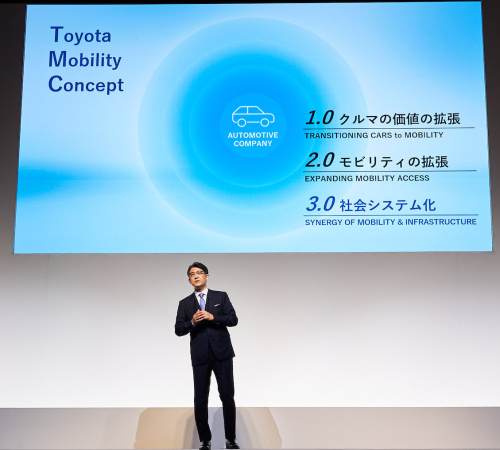Sato opened by saying that for the car to continue being a necessary part of society, the future of the car needs to be changed. There are two major themes associated with that, Sato said:
1.Carbon neutrality. Toyota is fully committed to achieving carbon neutrality in 2050 over the entire life cycle of its vehicles.
2.Car manufacturing. Toyota will continue to pursue a variety of options, based on a multi-pathway solutions, to stay close to the future of energy and the condition of each region.
First, we will thoroughly implement electrification, which we can do immediately. To steadily reduce CO2 emissions from where we stand now, we will promote the practical popularization of electrified vehicles. We will strengthen sales of hybrid electric vehicles, including in emerging markets, and increase the number of plug-in hybrid electric vehicle options. We will expand our lineup of battery electric vehicles, or BEVs, which represent one important option, over the next several years.
At the same time, we are boldly preparing for the future. As one of our efforts, we will do our utmost to develop next-generation BEVs for the era of BEV popularization and create new business models. And we will also accelerate projects for the realization of the hydrogen society that lies just beyond. With partners across industries and countries, we will advance the expansion of the realm of using hydrogen by such means as social implementation in Thailand and Fukushima, the mass production of commercial fuel cell electric vehicles, and the development of hydrogen engine technologies in the arena of motorsports. Furthermore, we will work with the energy industry to develop technologies for carbon-neutral fuels.
—Koji Sato
Through this all-direction approach, Toyota aims to reduce average CO2 emissions its vehicles sold worldwide by 33% by 2030 and by more than 50% by 2035 compared to 2019.It will continue to promote decarbonization globally and steadily toward 2050.

Koji Sato explaining Toyota Mobility Concept
Connected cars and the data they provide is also central to Toyota’s mobility concept. In “Mobility 1.0”, Toyota aims to extend the value of the car by connecting various types of movement. For example, BEVs offer new possibilities as mobility that transports electricity. Collectively serving as an energy grid, BEVs can enhance the energy security of society.
Intelligence can evolve cars even further by utilizing information gathered from cars and customers. The Toyota software platform Arene (earlier post) will be key to this new kind of car-making. Sato said that Toyota will do its utmost to develop a next-generation BEV for 2026 together with Woven By Toyota.
“Mobility 2.0” will expand mobility into new realms, including currently unsupported areas such as the elderly, people living in depopulated areas, and people in emerging markets in which the car market has yet to mature. New mobility possibilities, such as mobility in the sky, are also expanding.
“Mobility 3.0” is about integration with social systems—creating mobility ecosystems that tie into energy and transportation systems, logistics, as well as the way we live, and are integrated with cities and society. For example, Toyota will advance development of a new logistics system, the development of city-integrated autonomous mobility, and the demonstration of a CO2-free hydrogen supply chain that starts from Woven City, as well as a demonstration for expanding the potential of hydrogen use in daily lives.
Hiroki Nakajima will be in charge of products. Nakajima said that realizing the cision of the Toyota Mobility Concept will require electrification, intelligence and diversification.
Electrification. Toyota will continue to tailor electrification to the needs of customers and individual regions by drawing on the strengths and characteristics of each vehicle type.
The company will released ten new BEV models by 2026, which would amount to 1.5 million vehicles of annual sales. These are to include next-generation BEVs with doubled driving range.
1.In the US, Toyota will start the local production of a 3-row SUV in 2025.The SUV will be equipped with batteries to be produced in North Carolina, and the production capacity will be increased.
2.In China, in addition to the bZ4X and bZ3 which was announced last month, Toyota will launch two models of locally developed battery EVs in 2024, fit to the local needs., and will continue to increase the number of models in the following years.
3.By the end of the year, Toyota will start Asian production of battery EV pickup trucks and will also launch a small battery EV model.
Toyota will also transform manufacturing, reducing the number of processes by half. This will entail a shift to more efficient lines, including autonomous inspections and unmanned transport powered by connected technology.
To realize these transformations, we are creating a new specialized unit. Working under a single leader entrusted with full authority, this all-in-one team will handle every function, from development to production and business operation.
—Hiroki Nakajima
By increasing battery efficiency to extend the EV-mode driving range beyond 200 km, Toyota intends to reposition PHEVs as “the practical BEV” and will work harder on developing this as another BEV option.
For FCEVs, Toyota will pursue mass production centered on commercial vehicles.